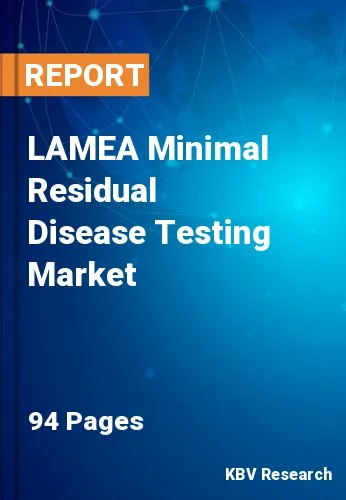The Latin America, Middle East and Africa Minimal Residual Disease Testing Market would witness market growth of 19.4% CAGR during the forecast period (2022-2028).
After primary cancer therapy, potential MRD diagnoses are essential for making intelligent individual and long-term clinical decisions. Additionally, MRD diagnosis effectiveness is critical for healthcare insurance firms to successfully provide financial aid to cancer survivors around the world.
Finally, the successful implementation of a particular cancer treatment regimen depends on the measurement of therapeutic results. As a result, MRD testing is being employed more frequently as the final stage of end-point analysis in several clinical trial studies for oncology-based research. It also efficiently captures variances in outcomes resulting from unique genetic traits.
In the coming years, major participants in the minimal residual disease testing market would have the opportunity for expansion in developing economies. This can be linked to the growing elderly population, the rising frequency of hematologic cancers, the rising cost of healthcare per person, and the development of the healthcare system.
In this region, leukemia is one of the leading causes of cancer mortality among children. As a result, it is considered the main health challenge. The restricted access to healthcare, socioeconomic disparities, and the significant lack of economic resources in the region lowers the survival rates that are conventionally witnessed in high-income nations. The delay in diagnosis, lack of supportive care, dearth of pediatric oncologists and nurses, and frequent treatment abandonment also result in increasing children mortality proportions in the region.
The Brazil market dominated the LAMEA Minimal Residual Disease Testing Market by Country in 2021, and would continue to be a dominant market till 2028; thereby, achieving a market value of $50.3 million by 2028.The Argentina market is experiencing a CAGR of 20% during (2022 - 2028). Additionally, The UAE market would display a CAGR of 19.1% during (2022 - 2028).
Based on Application, the market is segmented into Hematological Malignancies, Leukemia, Lymphoma, Solid Tumors and Others. Based on End User, the market is segmented into Hospitals & Specialty Clinics, Diagnostic Laboratories, Academic & Research Institutes and Others. Based on Technology, the market is segmented into Polymerase Chain Reaction (PCR), Next-Generation Sequencing (NGS), Flow Cytometry and Others. Based on countries, the market is segmented into Brazil, Argentina, UAE, Saudi Arabia, South Africa, Nigeria, and Rest of LAMEA.
Free Valuable Insights: The Global Minimal Residual Disease Testing Market is Predict to reach $2.7 Billion by 2028, at a CAGR of 14.2%
The market research report covers the analysis of key stake holders of the market. Key companies profiled in the report include Bio-Rad Laboratories, Inc., Guardant Health, Inc., Invitae Corporation (ArcherDX, Inc.), Bio-Techne Corporation, F. Hoffmann-La Roche Ltd., ICON plc (MolecularMD Corporation), Natera, Inc., Sysmex Corporation, Laboratory Corporation of America Holdings, and Invivoscribe, Inc.
By Application
By End User
By Technology
By Country
Our team of dedicated experts can provide you with attractive expansion opportunities for your business.

